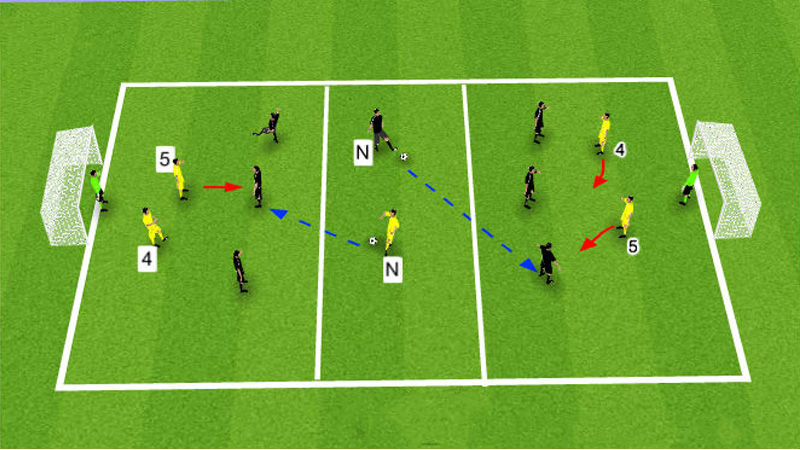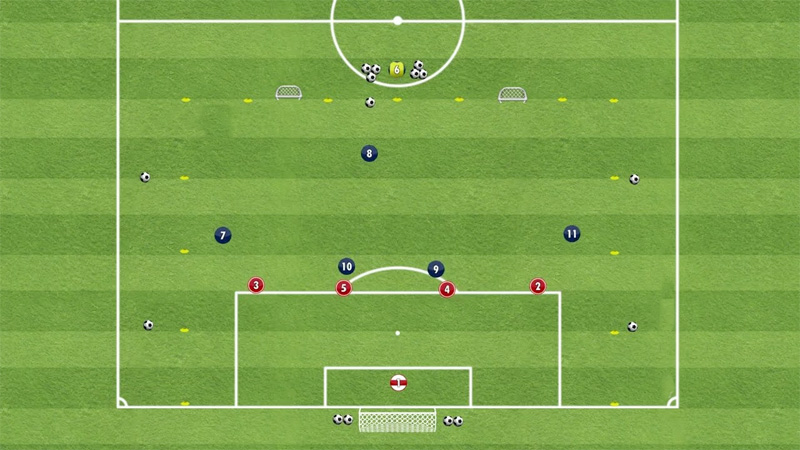In the thrilling world of soccer, where goals and glory are the ultimate rewards, the defensive third stands as an impenetrable fortress safeguarding the team’s dreams.
Just as a chain is as strong as its weakest link, a soccer team’s success heavily hinges on the robustness of its defensive organization.
The defensive third is the frontline of defense, where defenders valiantly battle opposing forwards, seeking to neutralize threats and thwart any attempts to breach their goal.
Understanding the significance of the defensive third and the strategies employed within this critical zone is fundamental to appreciating the intricate art of soccer tactics. So, let’s explore what are a defensive third in soccer and its purpose.
What Is a Defensive Third in Soccer?
The defensive third, also known as the defensive zone, refers to the area closest to a team’s own goal. In a standard soccer field, it comprises the last third of the pitch, stretching from the penalty area to the goal line.
Defenders and defensive midfielders are primarily responsible for guarding this area and preventing opposing players from advancing into dangerous positions near their goal.
Objectives of the Defensive Third

Source: sportsessionplanner
Wondering why defensive third is important in soccer? Here are the reasons:
Preventing Goal Scoring Opportunities
The primary objective of the defensive third is to deny the opposition any clear goal-scoring chances. This involves closing down attackers, intercepting passes, and blocking shots, thereby minimizing the chances of conceding a goal.
Clearing the Ball
When under pressure, defenders must quickly clear the ball out of their defensive zone to relieve the immediate danger. This is typically achieved through techniques like headers, long clearances, or tactical passes to the midfield.
Maintaining Defensive Shape
Defenders must maintain a compact and organized formation to deny the attackers space and passing lanes. This enables them to challenge the opposition collectively, reducing the risk of being beaten one-on-one.
Initiating Counter-Attacks
While the primary focus is on defending, a well-organized defensive third can become the starting point of a swift counter-attack. Intercepted passes or recovered balls can be quickly transitioned to the attacking players.
Strategies in the Defensive Third

Source: sportsessionplanner
Below are the top strategies soccer players use for effective defense:
Man-Marking
In this strategy, defenders are assigned to mark specific opponents, sticking to them closely and denying them space to receive the ball comfortably. It requires disciplined positioning and strong individual defensive skills.
Zonal Marking
In contrast to man-marking, zonal marking involves defenders covering specific zones rather than marking players. The defenders in each zone collaborate to close down attackers and maintain compactness.
Offside Trap
A riskier tactic, the offside trap involves defenders stepping up in unison, catching attackers offside and forcing turnovers. It requires impeccable timing and communication to avoid being beaten by a well-timed through ball.
Pressing
This high-intensity tactic involves the whole team applying pressure on the opposition in their defensive third. Defenders aim to win the ball back quickly and prevent the opposition from building attacks.
What Is Attacking Third in Soccer?
The attacking third in soccer is the offensive zone located closest to the opponent’s goal. It spans from the opponent’s penalty area to the goal line.
This area is of utmost importance as it provides the prime opportunity for teams to create goal-scoring chances and attempt to score.
Understanding the purpose and employing effective strategies in the attacking third can significantly enhance a team’s offensive prowess.
Purpose of the Attacking Third
While defending is essential to protect a team’s goal, the attacking third is where dreams of glory come alive, and fans witness the brilliance of attacking players in their quest for victory. Here’s why it’s important:
Goal Scoring Opportunities
The primary purpose of the attacking third is to create scoring opportunities. By penetrating the opponent’s defense and getting closer to their goal, teams increase their chances of taking shots on target and scoring goals.
Possession Retention
While in the attacking third, teams aim to maintain possession of the ball and control the game. This allows them to build sustained attacks and wear down the opponent’s defense, potentially leading to breakthroughs.
Drawing Defenders
As attackers move into the attacking third, they attract defensive players toward them, creating space in other areas of the field. This can be exploited by teammates to make runs and receive passes in advantageous positions.
Set-Piece Opportunities
The attacking third is where most set-piece opportunities, such as corners and free-kicks, are generated. These moments provide excellent chances to deliver the ball into dangerous areas and capitalize on defensive vulnerabilities.
Strategies in the Attacking Third
The attacking third in soccer represents the battleground where goals are forged, and matches can be won or lost. Here are some key strategies:
Width and Stretching
Players in the attacking third use the width of the field to stretch the opponent’s defense horizontally. Wingers or wide midfielders play a crucial role in providing width and creating space for central attackers to exploit.
Combination Play
Effective passing and quick combination play are vital in the attacking third. Players use short, precise passes to navigate through the defense and create openings for shots or through balls.
Overlapping Runs
Full-backs often make overlapping runs beyond the wingers to add additional attacking options and create confusion in the opponent’s defense. This strategy can lead to crosses into the box or cut-back passes.
Shooting from Distance
When the defense is compact, players might take shots from outside the penalty area as a way to surprise the goalkeeper and capitalize on rebounds.
High Pressing
Teams may employ high pressing in the attacking third, aiming to win back possession quickly after losing the ball and create immediate scoring chances.
What Is the Middle Third in Football?
In football (soccer), the “middle third” refers to the central area of the field, specifically the portion between the two penalty boxes. The pitch is often divided into three equal parts: the defensive third, the middle third, and the attacking third.
The middle third is crucial for both defensive and offensive strategies. It serves as a transitional zone where teams can build their attacks from the defensive third and progress toward the attacking third.
It is also a key area for regaining possession of the ball if lost, as winning the ball back in this region can quickly turn into a counter-attack.
In the middle third, midfielders play a vital role as they are responsible for connecting the defensive and attacking lines. They facilitate ball circulation, control the tempo of the game, and often initiate attacks by passing the ball forward to the attacking players.
Overall, the middle third is a critical part of the field where much of the game’s play and tactical maneuvering take place. Teams aim to control this area to gain an advantage over their opponents and create scoring opportunities.
Why Knowing Thirds Fundamental in Soccer?
Knowing how to utilize thirds is fundamental in soccer because it helps teams effectively control the game, create scoring opportunities, and maintain defensive stability.
The concept of thirds refers to dividing the soccer field into three equal horizontal sections, both in the offensive and defensive phases of the game. These thirds are typically referred to as the defensive third, middle third, and attacking third. Here’s why knowing thirds is crucial in soccer:
Build-up Play
When in possession of the ball, teams aim to progress it from their defensive third to the attacking third strategically. Understanding the importance of each third allows players to create passing lanes, maintain possession, and advance toward the opponent’s goal in a coordinated manner.
Effective Defending
In defense, teams employ various strategies depending on the third in which they are contesting possession. In the defensive third, players prioritize safety and controlled build-up from the back.
In the middle third, pressing and intercepting become essential. In the attacking third, teams often pressure higher up the field to force turnovers and create scoring opportunities.
Creating Space
Recognizing the thirds helps players create space on the field. By stretching the play horizontally, teams can create gaps and openings in the opponent’s defense, providing more options for ball movement and attack.
Scoring Opportunities
Teams that understand thirds can exploit defensive weaknesses and gaps in the opponent’s formation. Moving the ball effectively from the middle third to the attacking third allows for more goal-scoring opportunities, as players are positioned closer to the opponent’s goal.
Transition Play
Soccer is a game of transitions, and understanding thirds aids in transitioning between attacking and defending quickly. Effective transitions are essential for counter-attacks, turning defense into attack, and vice versa.
Tactical Flexibility
Knowing thirds allows teams to be tactically flexible. They can adapt their strategies depending on the scoreline, time left in the game, and the strengths and weaknesses of the opposition.
Pressing and Regaining Possession
In modern soccer, high pressing is common, particularly in the middle third and attacking third. Pressing in these areas can lead to regaining possession quickly and setting up goal-scoring chances.
Defensive Compactness
Understanding thirds is vital for defensive organization. Teams need to maintain a compact shape in the defensive third, making it harder for the opposition to penetrate and reducing the risk of conceding goals.
Overall, knowing thirds in soccer is a fundamental concept that helps teams efficiently manage their gameplay, maximize their attacking potential, and maintain defensive solidity.
Coaches and players use this knowledge to develop strategies and tactics that can make a significant difference in the outcome of a match.
FAQs
What is the offside rule in soccer?
The offside rule in soccer states that an attacking player is considered offside if they are nearer to the opponent’s goal line than both the ball and the second-to-last defender (usually the last outfield player) at the moment when the ball is played to them.
What is added time (injury time) in soccer?
Added time, also known as injury time or stoppage time, is the additional minutes played at the end of each half to compensate for time lost due to injuries, substitutions, and other stoppages during regular play.
How many players are there in a soccer team?
In a standard soccer match, each team fields 11 players, including one goalkeeper and ten outfield players. The outfield players are usually divided into defenders, midfielders, and forwards, each with specific roles and responsibilities on the field.
What is the duration of a soccer match?
A standard soccer match consists of two halves, each lasting 45 minutes, resulting in a total playing time of 90 minutes. There is a 15-minute halftime break between the two halves. If the match ends in a draw during regular play, some competitions might have extra time and penalty shootouts to determine the winner.
How is the winner determined in knockout stage matches?
In knockout stage matches, where a winner must be decided, if the score is level at the end of regular time, two periods of extra time are played. Each period is typically 15 minutes long, and teams switch sides after the first period. If the score is still tied after extra time, a penalty shootout is used to determine the winner.
Final Words
So, now you know what is a defensive third in soccer. In the grand theater of soccer, where every match unravels unique narratives, the defensive third remains an indispensable protagonist in the pursuit of victory.
A cohesive and resolute defense can turn underdogs into giants and champions into legends. From the precision of man-marking to the elegance of zonal marking, defenders stand as sentinels, ceaselessly protecting their territory.
By mastering the art of defending in the defensive third, teams can create a solid foundation upon which attacking brilliance can flourish.
As the beautiful game continues to captivate hearts worldwide, the valor and resilience displayed in the defensive third will forever echo in the annals of soccer history.







